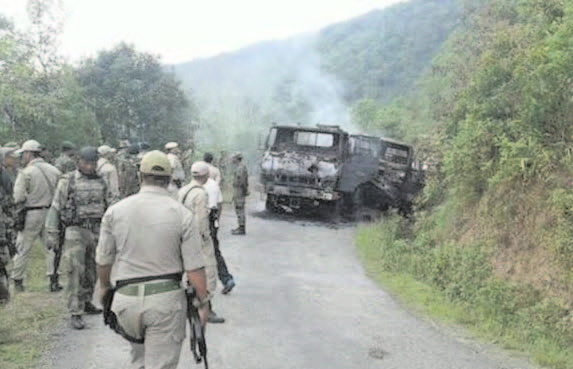GUWAHATI/IMPHAL/NEW DELHI (TIP): At least 20 soldiers were killed and over a dozen injured in a well-planned and clinically executed militant ambush in Manipur’s Chandel district on June 4 morning — the deadliest such blow to the Army since 1982 when 20 jawans were killed in the state leading to escalation of militancy for years to come.
Prime Minister Narendra Modi condemned the terror attack as “mindless” and “very distressing”. Defence minister Manohar Parrikar, home minister Rajnath Singh, national security advisor Ajit Doval and Army chief General Dalbir Singh Suhag went into a huddle to review the situation.
An immediate outcome was an order given to the Army to launch “all-out search and destroy” operations against militant hideouts in thick jungles along the Indo-Myanmar border as well as the hinterland in Manipur, sources said.
The chilling ambush rudely brought the Indian security establishment’s focus back to the northeast, often neglected due to its geographical distance from New Delhi — as compared to terrorism-hit Kashmir — despite its long porous borders with Myanmar and Bangladesh.
It also put the spotlight on the sudden escalation in violence in the region ever since Naga militant outfit NSCN(K) pulled out of the 14-year-old ceasefire with New Delhi in March.
In two ambushes soon after, 11 Army and Assam Rifles jawans were killed in Arunachal Pradesh and Nagaland on April 2 and May 3.
Experts fear an uneasy truce in the region, largely the result of ceasefire agreements signed between the Centre and several insurgent outfits over years, seems to be now unravelling.
The newly-floated common platform of United Liberation Front of Western South East Asia —which includes NSCN(K), Ulfa(I), Kamatapur Liberation Organization and NDFB(Songbijit) — claimed responsibility for the attack. Ulfa(I) leader Paresh Baruah called up some local television channels to claim that NSCN(K) chief and front chairman S S Khaplang had ordered the hit.
It was around 8.15am on June 4 that a convoy of 6 Dogra Regiment was ambushed near Paraolong village in southeast Manipur, near the Myanmar border. IED blasts first ripped apart Army trucks before rocket-propelled grenades and heavy automatic fire from a hillock felled the soldiers.
One junior commissioned officer and 19 soldiers were killed on the spot while over a dozen others were later airlifted to a military hospital after a major operation was mounted to sanitize the ambush site and undertake combing missions. The Army battalion had probably let down its guard since it was in the process of being de-inducted from the Moltuk Valley after completing its tenure there.
Initial assessment by security establishment in New Delhi had held that the ambush was probably the handiwork of Manipuri Meiti insurgent groups such as People’s Liberation Army (PLA) and Kanglei Yawol Kanna Lup (KYKL), working in close conjunction with NSCN (K).
With the government ordering an “all-out offensive” against the militant outfits, violence is likely to escalate in the region. Comparisons were, in fact, being drawn with the similar ambush dating back to February 1982 when 20 jawans of 21 Sikh and one civilian were killed at Namthilok between Imphal and Ukhrul.
